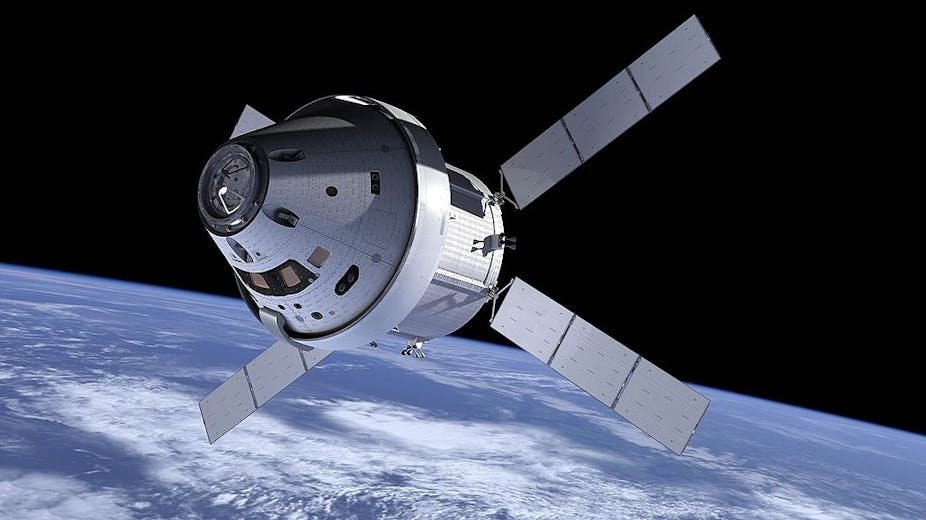Generations of mariners have spent time anxiously watching the weather, waiting for the right conditions. It seems that despite all the high-tech advances we’ve made, spacecraft are still subject to the vagaries of the weather.
The Orion module, the vessel which will carry a new generation of astronauts beyond Earth orbit, had to remain Earth-bound for several days beyond its scheduled launch date because of high winds at Cape Canaveral. Fortunately, its launch went flawlessly: the enormous spacecraft lifting-off dramatically into the Florida dawn.
Cameras on the outside of the fairing gave tremendous views of the curve of the Earth, and the thin line of the atmosphere as the rocket ascended. It travelled to an altitude of about 6,000km – to put this into perspective, the International Space Station orbits at about 430km, and the maximum Space Shuttle altitude was below 1,000km, while geostationary satellites orbit around 40,000km above the Earth’s surface. The Moon is 385,000km away.
Just over four hours later, having circled the Earth twice, the probe made an equally awesome re-entry into the atmosphere and splashdown in the Pacific, parachutes billowing.
Beyond Earth
There is huge interest and investment in the success of the Orion venture. We have followed the activities of astronauts on the International Space Station with varying levels of engagement – for example, the Canadian astronaut, Commander Chris Hadfield, has notched up 24 million hits for his rendition of David Bowie’s Space Oddity during his flight on the ISS. But travel to the ISS is still a local neighbourhood activity. We are eager to escape the grip of Earth’s gravity and beyond, or at least to the Moon and then Mars. The Orion vessel is the next stage in the journey, following the trail of the Apollo astronauts back to the Moon, then, we anticipate, blazing a trail to Mars.
Before any of that can happen, though, Orion has to complete its test programme. The current mission, with no crew on-board, is designed to test re-entry capability. The outer part of the capsule will become incandescently hot – up to 2000°C as it decelerates from about 30,000km per hour on its flight through the atmosphere. Insulating the interior of the capsule from this heat is a crucial test of the module’s design.
Beyond the solar system
Assuming the flight is successful, what are the next stages in the programme? One of the technical reasons for the hiatus in human space exploration beyond Earth orbit has been the lack of a heavy lift vehicle. The Saturn V launcher used for Apollo was not re-commissioned, on the basis of cost. It has taken the intervening 40 years to develop the Delta IV rocket which launched Orion, and there will be at least another year before the Falcon Heavy (the launch vehicle designed and built by Space X for NASA) is ready for a test flight with Orion on board.
Human spaceflight beyond Earth orbit is expensive, and even NASA cannot now carry the costs alone. ESA is an important partner in the Orion project, as are private companies such as Space X, Boeing, etc. Decisions about mission priorities will have to be taken internationally, so once the crew-carrying module and its launch vehicle are on the launch pad – where will they go? To the Moon, to establish a lunar base? To Mars, to start human exploration of the Red Planet? There are still many obstacles to overcome: a new lunar rover and plans for in-situ resource utilisation for fuel on the Moon are probably the readiest to achieve. Neither NASA nor ESA believe that the appropriate technologies for human exploration of Mars will be in place much before 2030, especially given that no space agency yet has a craft capable of landing on Mars and taking off again.
Human spaceflight to Mars should not be seen as a one way opportunity – even though the Mars One, not for profit project, is planning to send four volunteers to establish a settlement on the planet by 2025. The project has attracted much international attention, although experts, including Chris Hadfield, have spoken against the mission, considering it to be underprepared.
The success of the Orion test flight, or more specifically, its return, is an encouraging step along the path to Mars. Although, of course, we have to make sure that the wind is blowing in the correct direction.

